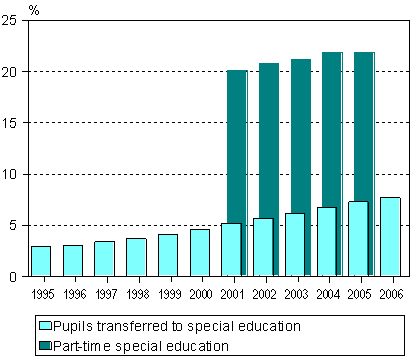Published: 15 June 2007
Number of pupils increased in full-time but decreased in part-time special education
In autumn 2006, a total of 44,700 comprehensive school pupils, or eight per cent of all pupils attending comprehensive school, had been transferred to full-time special education. Although the total number of pupils attending comprehensive school diminished by one per cent, the number of transfers to special education went up by four per cent from the previous year. The number has now been growing for more than a decade. By contrast, after many years of growth the number of pupils attending part-time special education declined slightly. In the 2005-2006 academic year, comprehensive school pupils attending part-time special education numbered 128,000, one per cent fewer than one year previously. However, the share of pupils attending part-time special education among all comprehensive school pupils remained at 22 per cent, that is, unchanged from one year earlier. These data derive from Statistics Finland's Education Statistics.
Almost one-half of the pupils having been transferred to special education were fully or partly integrated into groups attending general education and just over one-half received teaching in special groups or special comprehensive schools in autumn 2006. Special education is increasingly provided in connection with general education. Consequently, the number of pupils attending special schools has been falling throughout the 2000s. The arrangement of teaching in special education varies clearly by region. For example, in the Regions of Ostrobothnia and Lapland, fewer than one in three of the pupils having been transferred to special education were taught in special groups, whereas in the Regions of Åland and Kymenlaakso more than two-thirds attended special groups.
In autumn 2005, a total of 13,900 vocational education students, or six per cent of all vocational education students, received special teaching. One in two of them studied in the fields of technology or transport and one in five in the fields of tourism, catering or economics. Final data concerning special vocational education in 2006 will become available in December 2007.
Shares of pupils transferred to special education and receiving part-time special education among all comprehensive school pupils 1995-2006, %

Comparable data on part-time special education are available for the 2001-2005 period (year 2005 referring to the 2005-2006 academic year). The numbers of pupils transferred to special education and recipients of part-time special education cannot be added together because some of the pupils transferred to special education also receive special teaching part-time.
Source: Education Statistics, Statistics Finland.
Inquiries: Ms Riikka Rautanen +358 9 1734 2375,koulutus.tilastot@stat.fi
Director in charge: Mr Jari Tarkoma
- Tables
-
Tables in databases
Pick the data you need into tables, view the data as graphs, or download the data for your use.
Last updated 15.6.2007
Official Statistics of Finland (OSF):
Support for learning [e-publication].
ISSN=1799-1617. 2006. Helsinki: Statistics Finland [referred: 14.12.2025].
Access method: http://stat.fi/til/erop/2006/erop_2006_2007-06-15_tie_001_en.html

